Redundant Array of Independent Disks (RAID)
What is RAID? Redundant Array of Independent Disks Explained
Definition and meaning of Redundant Array of Independent Disks (RAID)
RAID, or Redundant Array of Independent Disks, is the combining of a couple of physical hard drives to seem and act as a single Digital/logical disk. There are quite some Methods to do that, called “tiers.”
Some RAID degrees, consisting of RAID 1 or RAID 5, are usually deployed, though there’s Constant debate over which level works pleasant and underneath which situations. RAID levels together with 2, 3, and four are hardly ever carried out for various motives, and seven is a proprietary Implementation.
If you need to steady your statistics in opposition to Hardware Failure, a RAID stage that gives redundancy via mirroring or Parity is a should. It’s a sad day whilst a solo drive or striped/no parity RAID 0 array is going stomach up. Recovery is commonly viable however very highly-priced. RAID with mirroring or parity additionally permits you to maintain working until the faulty pressure is replaced. That can prEvent scads of money.
RAID Ranges that growth sustained Throughput (random get right of entry to generally suffers slightly in any RAID setup) via striPing or otherwise distributing statistics throughout multiple disks can also be of superb advantage. They allow you to leverage older, slower Storage technology which include 250MBps tough drives or even 550MBps SATA SSDs into garage that can move large quantities of inFormation a ways quicker. We’ve visible even small four-bay NAS packing Containers exceed 1GBps with striping.
Hardware vs. Software RAID
Hardware RAID is implemented via devoted Controllers (HBAs or Host Bus Adapters), while Software Program RAID is applied thru an working sySTEM using everyday CPUs. You would possibly assume most NAS bins are hardware RAID. In fact, it’s more regularly Software RAID carried out via the OS that also gives the other Functionality. That’s why nowadays’s NAS boxes are so flexible.
The working Device is generally Linux with quit-person boxes, and FreeBSD or different Unix editions jogging Record systems which includes ZFS or OpenZFS come into play whilst you reach the larger Business or organisation degree.
Software RAID is easier to implement, replace, and improve, however Committed hardware conTrollers normally have a bonus in Velocity, ease of implementation, and fashionable recogNition on tasks.
RAID Levels
Here, we describe the diverse RAID stages, from primary to not-so-simple, the slow to the quick, and the secure to not-so-safe.
Note that usable Capacity shown in every callout is the percentage of the raw disk capacity that remains to be had after the RAID degree is implemented. For example, two 12TB difficult drives in RAID 1 offer 24TB of uncooked potential however handiest 12TB (50%) usable capability.
JBOD (Just A Bunch Of Disks)
Though not virtually a RAID stage, JBOD is usually presented as an choice with multi-power storage containers. All it way is that the drives seem as one logical unit, and statistics cascades down the road. When the first disk is full, information is written to the next, and so forth.
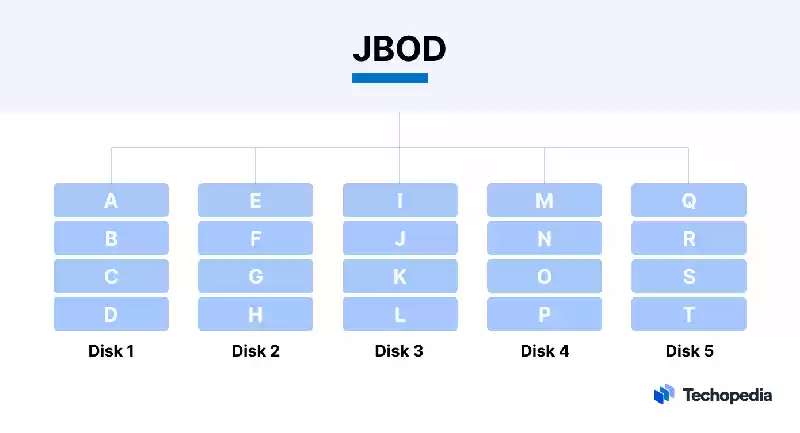
It’s a pleasing way to experience you aren’t going to run out of area but offers no redundancy or elevated performance.
- Pro: a hundred% usable capability
- Con: Decreased safety, no performance improvement
- Requirements: 2 or more drives, controller, or software
RAID zero (Disk Striping)
RAID zero distributes information evenly throughout disks for notably improved sustained throughput however without the safety advantages (or overhead) of writing parity statistics or mirroring.
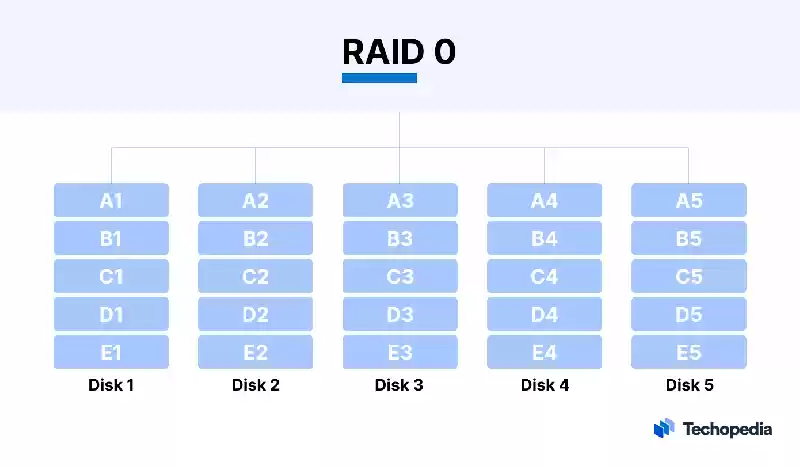
RAID zero is dangerous because the failure of one pressure brings the whole array down. The Greater disks inside the array, the greater failure points. This stage, until blended with other RAID levels, ought to best be used for scratch operations or, if crucial records is involved, Constantly subsidized up. Recovery is normally possible but very high priced.
- Pro: Increased sustained throughput, one hundred% usable capacity
- Con: Decreased protection
- Requirements: 2 or extra drives, controller, or software
RAID 1 (Disk Mirroring)
RAID 1 is developing an actual copy of 1 disk on some other. Basically, records is written to all drives on the equal time. You may have as many mirrors as you need, however normally drives are paired. Should one fail, you continue to have a functional disk to work off of while the failed disk is replaced and the array rebuilt (the present information copied to the new drive).
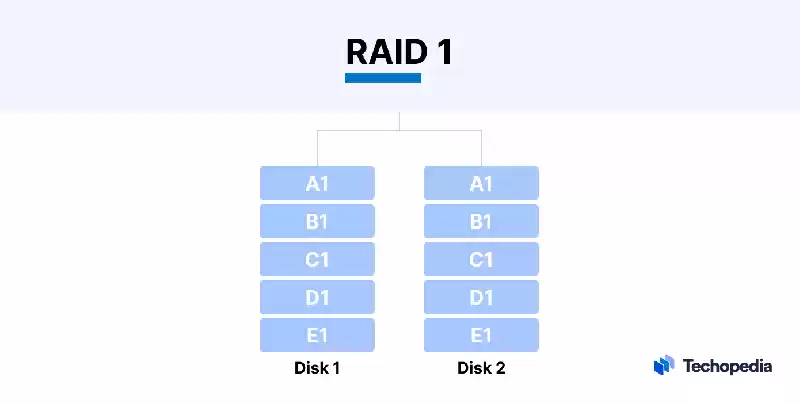
RAID 1 mirrors are often blended below other RAID degrees (RAID 10, and many others.) for elevated overall performance while keeping redundancy. The instead big disadvantage to RAID zero is which you lose half of your raw capability.
- Pro: Increased statistics safety
- Con: No growth in performance, 50% usable ability
- Requirements: 2 or more drives, controller, or software program
RAID 1E (Striped Mirroring)
RAID 1E is striping a reproduction (mirrored) Block of facts to a distinct force in a set of 3 or greater. It’s now not the parity Data you’ll Discover in ranges together with 5, but an real duplicate/reflect of the records. The statistics bLock and the mirror/duplicate block can be on any of the drives as lengthy as it’s now not the same one. Like undeniable RAID 1, usable ability is half of the whole capability.
- Pro: Increased sustained throughput and facts safety
- Con: Only 50% usable ability
- Requirements: 3 or greater drives, controller, or software program
RAID 2 (Bit striping with Parity and Error Correction)
In exercise, RAID 2 has confirmed hard and expensive to implement. A controller spreads records on the bit degree across a couple of difficult drives with Hamming (linear mistakes correction) Code used to accurate errors and provide parity bits.
Error Correction Code (ECC) on Modern-day difficult drives has largely removed the need for Hamming, however there's nonetheless a primary technical hurdle in synchronizing the spindles for unmarried-bit operations. Also, as all spindles are in play for each write, best one write operation at a time is viable. This Makes for extremely rapid sustained throughput but awful multi-Transactional (random) performance.
- Pro: Increased sustained throughput and records safety
- Con: Spindles have to be synced, decreased random overall performance, sixty six% usable potential
- Requirements: 2 or extra drives, controller, or software
RAID three (Byte Striping with a Single Parity Disk )
Like RAID 2, RAID three is every other stage that appears like it will provide a nice performance boost: bytes striped across more than one disks with all of the parity data saved on a separate disk. But once more, synchronized spindles were required, and overall performance is wonderful for sequential reads and writes however weak for multi-tasking read and write operations.
- Pro: Increased sustained throughput, greater safety
- Con: Spindles ought to be synced, reduced random overall performance, 66% usable capability
- Requirements: three or greater drives, controller, or software
RAID 4 (Block Striping with a Single Parity Disk)
RAID four is much like RAID 5 in that it strips statistics at the block level across a couple of disks (at the least 3). However, unlike RAID five, which distributes parity data across all of the disks in the array, RAID 4 parity is written to a unmarried disk. The one Pipe for parity may be a bottleneck below heavy loads.
- Pro: Increased sustained throughput, extra protection
- Con: Spindles must be synced, reduced random performance, 66% usable capability
- Requirements: three or more drives, controller, or software
RAID five (Block Striping with Distributed Parity)
RAID 5 calls for at least 3 drives and is similar to RAID 0 in that it strips (distributes evenly) records at the block level across more than one disks. However, in contrast to its lifestyles-on-the-facet cousin, it additionally strips parity info throughout all the drives inside the array for statistics redundancy.
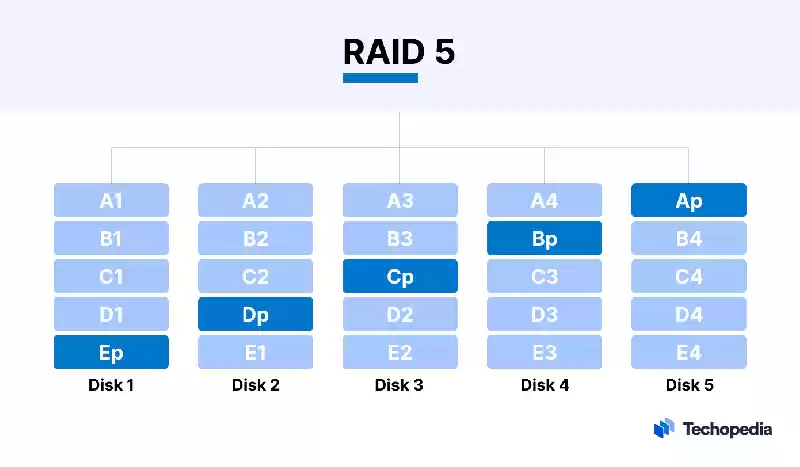
Parity blocks by no means are living on the disk that carries the facts they shield. RAID 5 is the lowest RAID stage to use disbursed parity. RAID 5 can face up to the loss of one pressure.
- Pro: Increased sustained throughput, greater safety
- Con: Nothing to speak of, 66% usable capacity
- Requirements: three or greater drives, controller, or software program
RAID 5E (RAID five with Distributed Hot Spare)
The E in RAID 5E stands for extended or more desirable, depending on who you speak to. Extended/enhanced, as in an extra disk, is covered inside the array as a warm spare, but that simply functions as a part of the array. The spare capability represented via the greater disk is spread over all the disks in the array in big contiguous areas on the stop of the records on each disk.
The minimal number of disks is four in 5E, but in any other case, it’s RAID five striping with distributed parity.
- Pro: Increased sustained throughput, terrific safety
- Con: Long reBuild Instances, 50% usable capability
- Requirements: four or greater drives, controller, or software program
RAID 5EE (RAID five with Distributed/Interleaved Hot Spare)
RAID 5EE is The identical as 5E, but the empty space that the “hot spare” represents is interleaved with the relaxation of the facts rather than in massive contiguous blocks on the stop of the facts on every power. Recovery time is said to be faster than with RAID 5E.
- Pro: Increased sustained throughput, extremely good protection
- Con: Long rebuild instances, 66% usable capacity
- Requirements: 4 or greater drives, controller, or software program
RAID 6 (Block Striping with Double Parity)
RAID 6 is a close cousin to RAID five in that records and parity information are striped across all the disks in the array. However, RAID 6 distributes twice the parity info–two blocks for each block of records, as opposed to RAID 5’s one. The original statistics block, parity block one, and parity block two all are living one at a time.
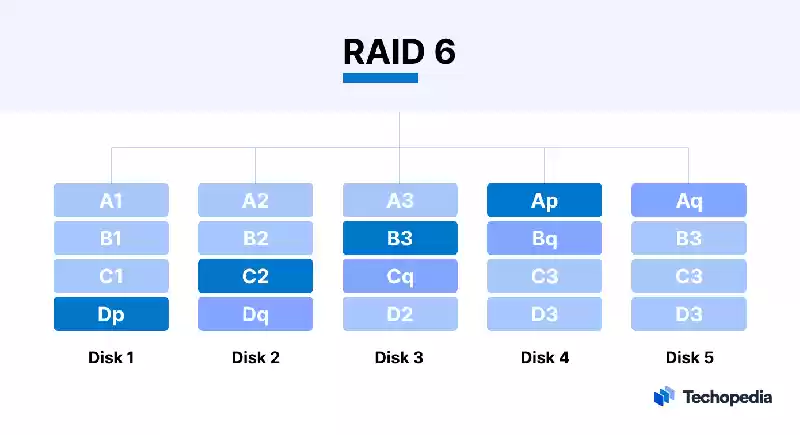
RAID 6 calls for at the very least four drives and may withstand the lack of two drives and hold on ticking. Normal RAID 5 can tolerate most effective a unmarried force failure.
- Pro: Increased sustained throughput, pleasant protection
- Con: Long rebuild times, 50% usable ability
- Requirements: four or extra drives, controller, or software program
RAID 7 (Proprietary)
RAID 7 isn’t one of the standard RAID levels but a proprietary solution integrating a CPU and controller presented by means of Storage Computer Corporation (now defunct). RAID 7 utilizes RAID 3 and RAID four functions at the same time as including the benefits of caching.
RAID 10 (RAID 1 zero)
RAID 10 is a mixture of RAID 1 mirroring and RAID 0 striping. It’s also referred to as 1 zero, and we’ve additionally visible it as zero 1. Data is striped in RAID zero style throughout one or greater RAID 1 mirrors.
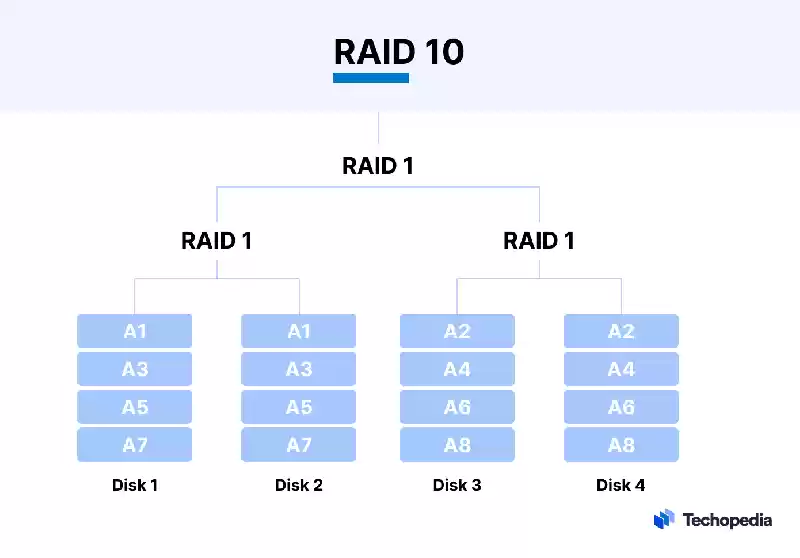
RAID 10 can withstand the lack of drives so long as they’re now not both in the same reflected pair.
- Pro: Increased sustained throughput, superb protection
- Con: Long rebuild instances, 50% usable potential
- Requirements: 4 or more drives, controller, or software
RAID 50 (RAID 5 0)
RAID 50 is RAID zero striping (no parity) across or extra RAID 5 arrays. The RAID five arrays offer the parity and facts redundancy that degree 0 is lacking. You may want to conceivably leverage 5E or 5EE arrays as well. RAID 50 is faster than RAID 5 however calls for six disks minimum. As with RAID 5, usable storage is 66% percent of total ability.
- Pro: Increased sustained throughput, top notch safety
- Con: Long rebuild instances, sixty six% usable capability
- Requirements: 6 or extra drives, controller, or software
RAID 60 (RAID 6 0)
RAID 60 is information striped RAID 0 fashion throughout two or greater RAID 6 double parity sub-arrays. It offers two times the facts redundancy of RAID 50 however, of course, requires extra disks: four consistent with RAID 6 array for a complete of eight minimal. It’s quicker than a single RAID 6. How a whole lot so depends on your pile and the wide Variety of RAID 6 sub-arrays. Usable potential is 50% of general capacity.
- Pro: Increased sustained throughput, exCellent facts safety
- Con: Long rebuild instances, 50% usable ability
- Requirements: 8 or more drives, controller, or software program
RAID one hundred (RAID 10 0)
This is double-Stacking RAID zero, or striping in RAID 0 fashion without a parity throughout multiple RAID 10 arrays, which themselves stripe facts RAID 0 fashion across more than one RAID 1 mirrored arrays. Whew.
Obviously, with so many pipes, RAID one hundred may be very rapid while still keeping the redundancy of mirroring. It calls for 8 drives minimum.
- Pro: Increased sustained throughput, high-quality information safety
- Con: Long rebuild instances, 50% usable capability
- Requirements: 8 or more drives, controller, or software
RAID Level Attribute Comparison Table
Though we’ve spelled out the primary differences in RAID stages, it’s constantly excellent to peer the fundamentals compared in tight quarters. We’ve left out the non-starters.

Let's improve Redundant Array of Independent Disks (RAID) term definition knowledge
If you have a better way to define the term "Redundant Array of Independent Disks (RAID)" or any additional information that could enhance this page, please share your thoughts with us.
We're always looking to improve and update our content. Your insights could help us provide a more accurate and comprehensive understanding of Redundant Array of Independent Disks (RAID).
Whether it's definition, Functional context or any other relevant details, your contribution would be greatly appreciated.
Thank you for helping us make this page better!
Frequently asked questions:
Your Score to Redundant Array of Independent Disks (RAID) definition
Score: 5 out of 5 (1 voters)
Be the first to comment on the Redundant Array of Independent Disks (RAID) definition article